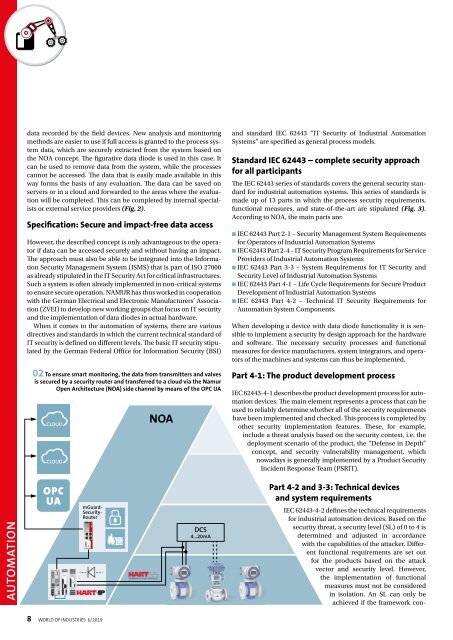WORLD OF INDUSTRIES 6/2019
WORLD OF INDUSTRIES 6/2019
WORLD OF INDUSTRIES 6/2019
- TAGS
- industrial
- industries
You also want an ePaper? Increase the reach of your titles
YUMPU automatically turns print PDFs into web optimized ePapers that Google loves.
data recorded by the field devices. New analysis and monitoring<br />
methods are easier to use if full access is granted to the process system<br />
data, which are securely extracted from the system based on<br />
the NOA concept. The figurative data diode is used in this case. It<br />
can be used to remove data from the system, while the processes<br />
cannot be accessed. The data that is easily made available in this<br />
way forms the basis of any evaluation. The data can be saved on<br />
servers or in a cloud and forwarded to the areas where the evaluation<br />
will be completed. This can be completed by internal specialists<br />
or external service providers (Fig. 2).<br />
Specification: Secure and impact-free data access<br />
However, the described concept is only advantageous to the operator<br />
if data can be accessed securely and without having an impact.<br />
The approach must also be able to be integrated into the Information<br />
Security Management System (ISMS) that is part of ISO 27000<br />
as already stipulated in the IT Security Act for critical infrastructures.<br />
Such a system is often already implemented in non-critical systems<br />
to ensure secure operation. NAMUR has thus worked in cooperation<br />
with the German Electrical and Electronic Manu facturers’ Association<br />
(ZVEI) to develop new working groups that focus on IT security<br />
and the implementation of data diodes in actual hardware.<br />
When it comes to the automation of systems, there are various<br />
directives and standards in which the current technical standard of<br />
IT security is defined on different levels. The basic IT security stipulated<br />
by the German Federal Office for Information Security (BSI)<br />
02 To ensure smart monitoring, the data from transmitters and valves<br />
is secured by a security router and transferred to a cloud via the Namur<br />
Open Architecture (NOA) side channel by means of the OPC UA<br />
and standard IEC 62443 “IT Security of Industrial Automation<br />
Systems” are specified as general process models.<br />
Standard IEC 62443 – complete security approach<br />
for all participants<br />
The IEC 62443 series of standards covers the general security standard<br />
for industrial automation systems. This series of standards is<br />
made up of 13 parts in which the process security requirements,<br />
functional measures, and state-of-the-art are stipulated (Fig. 3).<br />
According to NOA, the main parts are:<br />
n IEC 62443 Part 2-1 – Security Management System Requirements<br />
for Operators of Industrial Automation Systems<br />
n IEC 62443 Part 2-4 – IT Security Program Requirements for Service<br />
Providers of Industrial Automation Systems<br />
n IEC 62443 Part 3-3 – System Requirements for IT Security and<br />
Security Level of Industrial Automation Systems<br />
n IEC 62443 Part 4-1 – Life Cycle Requirements for Secure Product<br />
Development of Industrial Automation Systems<br />
n IEC 62443 Part 4-2 – Technical IT Security Requirements for<br />
Automation System Components.<br />
When developing a device with data diode functionality it is sensible<br />
to implement a security by design approach for the hardware<br />
and software. The necessary security processes and functional<br />
measures for device manufacturers, system integrators, and operators<br />
of the machines and systems can thus be implemented.<br />
Part 4-1: The product development process<br />
IEC 62443-4-1 describes the product development process for automation<br />
devices. The main element represents a process that can be<br />
used to reliably determine whether all of the security requirements<br />
have been implemented and checked. This process is completed by<br />
other security implementation features. These, for example,<br />
include a threat analysis based on the security context, i.e. the<br />
deployment scenario of the product, the “Defense in Depth”<br />
concept, and security vulnerability management, which<br />
nowadays is generally implemented by a Product Security<br />
Incident Response Team (PSRIT).<br />
AUTOMATION<br />
Part 4-2 and 3-3: Technical devices<br />
and system requirements<br />
IEC 62443-4-2 defines the technical requirements<br />
for industrial automation devices. Based on the<br />
security threat, a security level (SL) of 0 to 4 is<br />
determined and adjusted in accordance<br />
with the capabilities of the attacker. Different<br />
functional requirements are set out<br />
for the products based on the attack<br />
vector and security level. However,<br />
the implementation of functional<br />
measures must not be considered<br />
in isolation. An SL can only be<br />
achieved if the framework con-<br />
8 <strong>WORLD</strong> <strong>OF</strong> <strong>INDUSTRIES</strong> 6/<strong>2019</strong>















